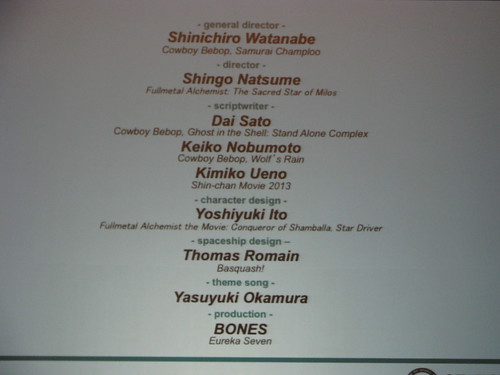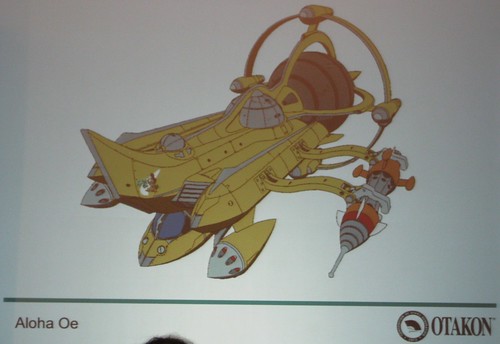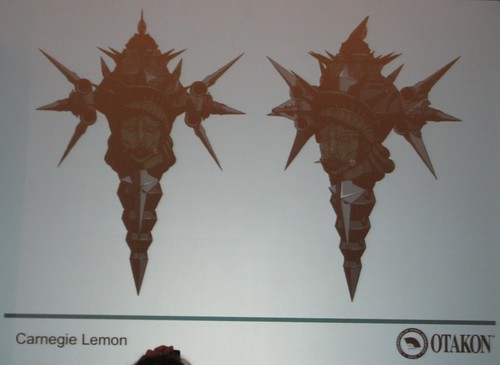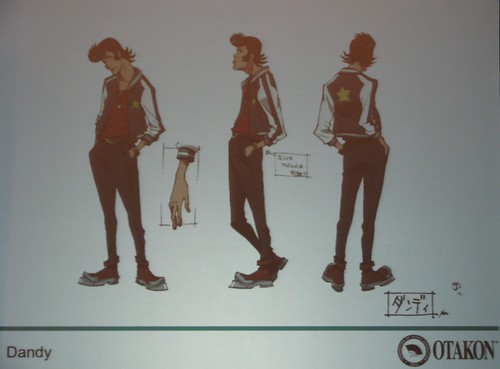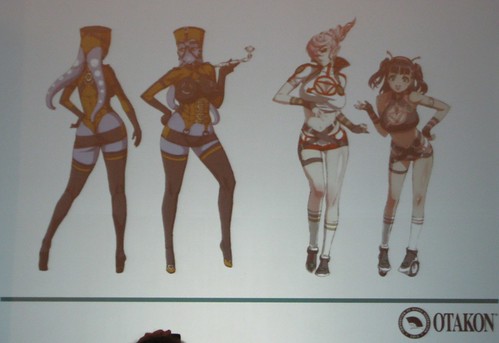Otakon 2013: Fifty Minutes with Shinichiro Watanabe
Space Dandy, Cowboy Bebop, and more at the exclusive press event
 Sitting beside BONES President Masahiko Minami, anime director Shinichiro Watanabe graciously answered questions from a collection of anime bloggers and journalists about his work, which includes Cowboy Bebop, Kids on the Slope, and the new project he announced at Otakon 2013: Space Dandy. After the break, you’ll find the complete transcript of the 50-minute session. Those of whom I recognized are identified before the question(s) they posed. Evan and I thank Mr. Watanabe and Mr. Minami for their time as well as the Otakon staff and the translator for providing this opportunity. It was an interview filled with laughter and humanity.
Sitting beside BONES President Masahiko Minami, anime director Shinichiro Watanabe graciously answered questions from a collection of anime bloggers and journalists about his work, which includes Cowboy Bebop, Kids on the Slope, and the new project he announced at Otakon 2013: Space Dandy. After the break, you’ll find the complete transcript of the 50-minute session. Those of whom I recognized are identified before the question(s) they posed. Evan and I thank Mr. Watanabe and Mr. Minami for their time as well as the Otakon staff and the translator for providing this opportunity. It was an interview filled with laughter and humanity.
Q (Daryl Surat): Space Dandy has similarities to ’70s sci-fi anime. Could you tell us if or how much influence Space Adventure Cobra had on the production?
Watanabe: Cobra is an anime that I like very much. I watched it when I was younger, but in terms of influence, I would say Space Dandy is more heavily influenced by even older sci-fi anime. In fact it’s influenced by numerous old sci-fi movies. So there’s no one movie in particular — it’s influenced by many of them. So to be a little more specific, it’s influenced by sci-fi movies in-between Forbidden Planet and Tron (the original).
Q (Ink): You recently worked with Sayo Yamamoto as musical producer on Michiko and Hatchin and Lupin III: The Woman Called Fujiko Mine. I was wondering if you could tell us what you did as a musical producer and how that role felt.
Watanabe: I like music a great deal, so with my anime director roles, I generally also play the anime music director as well. And there were some times when I would be looking at somebody else’s work, thinking “Oh, this could be so much better if they just did this and that with the music.” So I started playing the role of the music producer for other people’s anime projects. When I take up the role of the music producer, I make sure not to comment on the story or content of the animation, but instead I accept the director’s content of the animation and think about how I can tune the music to make this even better.
Q (Evan Minto): Was it difficult to switch from action series, like Cowboy Bebop and Samurai Champloo, to the more subdued story of Kids on the Slope? Was there anything that was particularly easier or more difficult to do than your previous work?
Watanbe: It wasn’t hard [laughs]. I’ve always wanted to direct a coming of age anime, but because Cowboy Bebop was such a success, and because Cowboy Bebop was an action anime, all of the offers that came to me were for action anime. So I just didn’t get the opportunity to work on a coming of age anime until Kids on the Slope. I always want to challenge myself by taking on directing roles for anime in genres I’ve never done before. So Space Dandy is going to be my attempt at taking on the comedy genre, which is something I’ve never done before.
Q: This is your first time since Cowboy Bebop: The Movie working with BONES as a director. What was it like coming back to the studio after so many years?
Watanabe: You know the President of BONES is sitting right here…. BONES is wonderful. Please, also ask the president of BONES, Mr. Minami, how it feel to work with me again.
Minami: He’s a wonderful director.
Q: Space Dandy’s getting so much of the creative talent that worked on Cowboy Bebop back together, and that show had seriousness and humor and everything else. Since Space Dandy is more of a comedy, can you talk about what kind of approach to humor viewers can expect compared to Bebop?
Watanabe: With Cowboy Bebop, it was 80% serious story with 20% of a humorous touch. Space Dandy is the opposite. With Space Dandy, 80% of it is as far from serious as you can possibly get. And the other 20% is a story of a less serious nature, heartwarming stories, or more hardcore sci-fi-type stories.
Q: One of the most interesting writers working in anime is Keiko Nobumoto, who tends to work with you a lot. I’m just interested in why she doesn’t seem to do much work beyond your projects and maybe one or two other things in anime.
Watanabe: Of all the script writers I’ve worked so far, Keiko is probably the one where we have the best synergy and the best group dynamic. If it were up to me, I would have her write a lot more scripts. [Humorously] But she’s a really slow worker, so she can only write so much.
Q: I’m interested in your decision to work with Thomas Romain. I believe he’s doing ship design for Space Dandy. How did you decide to work with him, and if style is part of the decision, how did you decide to make this a more comedic series compared to your previous works?
Watanabe: I’ve been familiar with his works for some time, and I’ve been very impressed with his work and thought he had a lot of talent in his designs. Unfortunately, he’s part of another company, Satelight, so usually we can’t ask him for help with our works. But with Space Dandy, we pulled some strings and begged him and we got special permission for him to help out. And the reason we got special permission is apparently because he’s a fan of Cowboy Bebop. Boy, was I thankful I directed Cowboy Bebop.
Q: In yesterday’s Q&A, you mentioned that a number of locations inspire you. Could you name a few and what in particular you love about them?
Watanabe: There’s two towns in particular that have given me a lot of inspiration. One is Rio de Janeiro, and the other is all the towns I visited in Morocco. You can see a lot of scenes reminiscent of Morocco in Cowboy Bebop: The Movie, and you’ll probably be seeing Rio sometime in the future. I’m secretly hoping that they’ll invite me for the World Cup, so please put this in your articles.
Q: I play the saxophone and am a big fan of jazz. I’m sure you get this question a lot, but I know there’s a big following of jazz in Japan and I was just kind of wondering, what were you first interactions with jazz? How did you really get into it? And did you do any research into jazz? Why did you decide to put it into a few of your shows, like Kids on the Slope and Cowboy Bebop?
Watanabe: I don’t remember exactly how I met jazz, but I remember it was something like I walked into a record shop and I was listening to “Kind of Blue” by Miles Davis. And it really inspired me. It really hit me. I fell in love with it right then, and I left the store with the record. With Kids on the Slope, I didn’t really have a need to study jazz for the show. If you read the original manga, there are a number of famous jazz songs that appear in it, but they were all songs I was already familiar with. So I didn’t need to put in any extra research into it … never mind. If you get me started, we’re going to go all day.
Q (Alain Mendez): Last night when you introduced Space Dandy, you had a lot of characters that you couldn’t get all the way through and you kind of had to rush through it. Could you, now that you have a little more time to speak, talk about a few of the characters in the show that you didn’t have time to flesh out?
Watanabe: I got permission from my boss just now. My boss, to my right, he’s going to kill me if I say too much. So I had to get permission first. So let’s see… With the main character of Space Dandy, Dandy, what we were aiming for is somebody who has no worries. The main characters for most anime, they worry about a lot of things, and the story revolves around them worrying about stuff. So I was thinking, “What if I had a main character who had no worries? What would the story be like?” In everyday life, we always have friction with other people, and we find ourselves worrying way too much about the smallest things. What if you had somebody who didn’t worry about any of those stupid things at all? It’s kind of an ideal within itself that we’re trying to pursue with Dandy. He is someone who operates on the scale of the universe, so he doesn’t worry about small things.
Q: You probably heard a few years ago that Keanu Reeves was trying to bring a live action Cowboy Bebop to the screen. Now that project has been put on hold as far as I know. I was wondering, first of all, do you think he would have made a good Spike? And number two: do you think in general anime translates well into a live-action movie?
Watanabe: With regards to a live-action Cowboy Bebop, if I say too much, Sunrise is going to get mad at me. So I’ll leave it at that. The one thing I can say is that the project isn’t at a halt. But at the same time, it’s also not moving. As for your question regarding live action versions of anime, I think it really depends on the anime. I think there are some anime that are easily adaptable to live action, but at the same time, there are certain anime that are probably best not being adapted to live action. To raise one example, there’s a certain Dragon-something that uh… [Crowd laughs]
Q: Your work and your directing style is kind of unlike anything that’s currently being made in anime. I’m interested: if you ever watch anime recreationally, what do you look for and what you like (besides everything from BONES … obviously)?
Watanabe: [Minami jokingly moves his chair further away from Watanabe] This is a hard question to answer. The anime series that has most inspired me is the first TV series for Lupin III. But there are many seasons and many TV series for Lupin III, so please be specific: Lupin III, the first TV series. The first is the best.
Q: Music is such an important part of your work in the past. For Space Dandy, can you talk about what kind of musical approach you’ll be taking this time? What kind of role it will play in the show?
Watanabe: With Dandy, we’ve asked numerous artists to contribute music to this show instead of just one. I imagine you’ll have about 20 different artists working on the show. So we’ve taken on the style of asking for three or four songs from each artist and getting many artists to work on the show. And all of the artists we have working on the show, of course, are my favorite artists. So I think we’ll have a great variety of music on the show. But there is one thing I ask of every artist who’s making music for the show, and that one request is to not use any instruments invented after 1984. So I think the music on the show is going to be a little old-school and retro.
Q: With so many artists working on this show, how do you keep everybody on track and unified so it sounds like one cohesive thing, or do you want it to sound kind of zany and off the wall?
Watanabe: So when we asked them to help us out on the show, we specifically request that they make music of a certain style. All the artists we’re asking to help on this show, they’re musicians that I personally like, so there won’t be any music on this show that I dislike. The musicians that are helping us, my boss is telling me that I can’t give you their names. So it’s still a secret for now.
Q (Daryl Surat): A previous artist that you worked on with Samurai Champloo who recently passed away was Nujabes. Can you tell us what it was like working with him on that project since now that he’s no longer with us.
Watanabe: The composer Nujabes is the first musician who came to mind when I thought of creating music for Samurai Champloo. I think we were able to perform a great, a spectacular collaboration together. And I had a dialog with him after we finished working on the show. Until then, he had been working almost exclusively in Japan, but for Samurai Champloo he got a lot of positive feedback from people outside of Japan. So he was very happy about that. And we had been talking about collaborating on a work again in the future, but that’s impossible now due to his passing away. So I’m very sad about that, that we won’t be able to work together again in the future.
Q (Evan Minto): You’re heavily influenced by Hollywood film, and your projects often use storytelling techniques associated with live-action film, so my question is: what attracts you to animation as opposed to creating live-action film?
Watanabe: Ok, first I’d like to make a correction: I believe you said Hollywood movie? That is not accurate. Please allow me to correct you: American movies from the ’70s. So as I said yesterday, when you’re making anime, if you get all of your inspiration from anime, then in your work, you can’t help but for it to be reminiscent of old anime, and it’s going to lack originality and creativity. So I try to get my inspiration from different genres to help my anime be more creative and original. But if I were ever to get the opportunity to direct a live-action movie, that is something I would be very much interested in doing.
Q: How much of Dandy is inspired by Cowboy Andy [from Cowboy Bebop]?
Watanabe: Are you asking this question because their names sound alike? One comment I’ve gotten from a lot of Cowboy Bebop fans is that they wanted to see more of Cowboy Andy. So with Space Dandy, we can’t show Cowboy Andy in the show due to intellectual property rights, but I think there will be some episodes in Space Dandy reminiscent of the type of episode we saw in Cowboy Bebop with Cowboy Andy.
Q (Ink): In Kids on the Slope, whose decision was it to employ an in-studio drummer so you could recreate that precision of drumming, and why was that decision made?
Watanabe: Yes, I was the one who insisted that we do that. All of the anime production staff around me, they were against it, but I paid no heed to their words. I’m very particular about the music I use in my works. There are a lot of performance scenes; I wanted to make sure it looked like they were actually performing in those scenes. But animating an actual performance scene is an incredible amount of work. So with most animes dealing with music, they don’t actually show the movements of the characters who are performing the instruments. Instead they show a lot of stills to sort of portray the image of the characters performing music. But I really dislike that style of animation when performing music, so I decided long ago that if I were ever to animate a musical performance, I would make it look like they were actually performing. But now that I’ve actually experienced animating a musical performance like that, I understand why nobody else does it. It’s an incredible amount of work.
Q: A lot of your work, stepping back kinda to your influences from Western sources, a lot of your anime feature, thematically and even in terms of character, explicit blending of Western and Asian motifs. Because we have Cowboy Bebop — you have the jazz, you have cowboys, you have kind of the noir detective stories in there. Samurai Champloo has hip-hop and the historical setting. Kids on the Slope even has multi-racial characters. Is that something you’re consciously drawn to, kind of this blending of West and East, or is that just something that kind of happens in the sort of stories you like to tell?
Watanabe: I think a lot of it comes unconsciously, unintentionally. So in Japan, many different cultures come into Japan. For example: with movies, you can see movies from many countries around the world in Japan. So I grew up in an environment where I’ve been exposed to cultures from many different countries. So I think it was natural that my work reflects many different cultures.
Q (Daryl Surat): Besides the obvious choices, like Dirty Harry or The French Connection or Samurai, could you maybe recommend some of the 1970s films that you’re a fan of for people to check out, so they can understand where you’re coming from a little better?
Watanabe: The first Dirty Harry is the best. There are many Dirty Harry movies out there, but the first one is the best. Sam Beckett, Bring Me the Head of Alfred Garcia, and The Ballad of Cable Hogue. And I also like Don Siegel, the director of Dirty Harry. I like many of his movies. So I’m not sure if I have the U.S. titles for this movie correct, but I really like the movie Killers. And another movie, where the Japanese title is Cage Madigan or Detective Meridan? And of course there are newer movies that I like also. I also like director John Carpenter. Space Dandy is greatly influenced by John Carpenter. Do you guys know the movie Dark Star? It’s heavily influenced by that.
Q: I know Yoko Kanno’s performing later today. You both worked on Cowboy Bebop — what were the kind of collaborations you did to kind of make sure it fit together as what she wanted, what you wanted too for your music. Also, if you were a jazz musician, what instrument would you play?
Watanabe: First, let me be on the record as saying she does not compose music exactly the way I tell her to. She gets inspired on her own, blows up her own imagery, and comes to me saying “This is the song we need for Cowboy Bebop,” and composes something completely on her own. So there were instances where I heard these songs she created for Cowboy Bebop, received inspiration from them, and created new scenes for Cowboy Bebop. And then she would be inspired by these new scenes I created. They would give her new ideas for music, and she would come to me with even more music. For example, some songs in the second half of the series … we didn’t even ask her for those songs! She just made them and brought them to us. Normally this is unforgivable. But with Cowboy Bebop, it was a new kid, so hakuna matata. So it was a game of catch in developing the music and creating the TV series Cowboy Bebop.
Q: Increasingly we’re seeing that anime’s becoming more and more insular, in that it often times seems to be made by anime fans for anime fans (sometimes about anime fans), and you’re making works for everybody. I’m interested if you feel like that’s kind of becoming a problem: bringing new people into anime to work on it.
Watanabe: My generation of animators are starting to become older and become veterans in the industry, so we believe it’s important to develop and nurture younger talent. So with staff of Space Dandy, of course there are some younger staff members who have never seen the old live action movies. So for those people, we forced them to watch Dark Star and Close Encounters of the Third Kind! So we forcefully make them absorb ideas of a different genre.
Q: I know that BONES has a tendency to sneak in a lot of hidden images into works, especially the studio name itself. Are there any plans to keep that tradition going with Space Dandy?
Watanabe: Let’s ask the president of BONES!
Minami: Of course! But it wouldn’t be a secret if we told you what they are. The TV series hasn’t started airing yet, but we will make sure it is something you can enjoy very much.
Watanabe: There is one thing I would like to mention about Space Dandy: in each episode, they’ll be going to a new planet. So the style of each episode will be very different episode-to-episode. And with the staff for each episode, for every episode there is a great creator that I respect immensely or fabulously talented designer. So we’re making sure every episode is unique and you can enjoy each episode. These creators and designers, they’re generally very busy people, and it’s hard to get their time for a project. But if you go up to them and say “just one episode,” it’s a lot easier to get their time. So you’ll see a great collaboration between multiple creators and designers. And of course I am just dying to share some of these names with you guys, but my boss to the right, he is saying no. So you’ll just have to wait until we slowly announce the staff for each episode.

